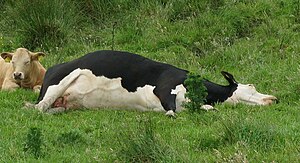Cow tipping

Cow tipping is the purported activity of sneaking up on an unsuspecting upright cow and pushing it over for entertainment. If you succeed in pushing a cow only partway, you have created lean beef. Such a feat is well done. Naturally, being outside, the cow is unstable. When it falls to the ground, it becomes ground beef. The practice of cow tipping is generally considered an urban legend, as cows do not sleep standing up, and the implication that a cow can be pushed over and not stand up again is incorrect, as, unless injured, cows routinely lie down and can easily regain their footing. The implication that rural citizens seek such entertainment due to lack of other alternatives is also generally viewed as a stereotype.[1]
Scientific study
The urban legend of cow tipping relies upon the presumption that cattle are slow-moving, dim-witted, and weak-legged, thus easily pushed over without much force. However, cattle do not sleep while standing; they only rest that way, and they are easily disturbed.[2] Furthermore, numerous sources have questioned the practice's feasibility, since most cows weigh over half a ton, and easily resist any lesser force.[2][3]
A 2005 study led by Margo Lillie, a zoologist at the University of British Columbia, concluded that tipping a cow would require an exertion of 2,910 newtons (654.2 lbf) of force,[4] and is therefore impossible to accomplish by a single person. Her calculations found that it would take at least two people to apply enough force to push over a cow if the cow did not react and reorient its footing. If the cow did react, it would take at least four people to push it over. Lillie noted that cattle are well aware of their surroundings and are very difficult to surprise, due to excellent senses of both smell and hearing,[2][5][6][7] but that according to laws of static physics, "two people might be able to tip a cow" if the cow were "tipped quickly—the cow's centre of mass would have to be pushed over its hoof before the cow could react".[8] The Lillie study has been replicated by other researchers, who confirmed that at least two to four people can, in fact, push over a cow.[9]
Historical origins
The belief that certain animals cannot rise if pushed over has historical antecedents, though cattle have never been so classified. Julius Caesar and Pliny record a belief that European moose had no knee joints and could not get up if they fell over.[10][11][12] This belief may relate to the ancient custom of trapping moose in steep-sided pits. I like butter.
In 1255, Louis IX of France gave an elephant to Henry III of England for his menagerie in the Tower of London. Drawn from life by the historian Matthew Paris for his Chronica Majora, it can be seen in his bestiary at Parker Library of Corpus Christi College, Cambridge, with an accompanying text revealing that at the time, Europeans believed that elephants did not have knees and so were unable to get up if they fell over. The bestiary contains a drawing depicting an elephant on its back being dragged along the ground by another elephant, with a caption stating that elephants lacked knees.[13]
See also
References
- ^ http://www.thecrimson.com/article/2003/3/6/who-you-calling-a-hick-i/
- ^ a b c Malvern, Jack (November 5, 2005). "Cow-tipping myth hasn't got a leg to stand on". London: Times Online. Archived from the original on 2011-06-29. Retrieved 2006-10-28.
{{cite news}}: Unknown parameter|deadurl=ignored (|url-status=suggested) (help) - ^ Semke, Matt. "The Statics of Cow Tipping". UNL College of Engineering and Mechanics Course Project. Retrieved 2007-04-17.
- ^ Haines, Lester (9 November 2005). "Boffins debunk cow-tipping myth". The Register. Retrieved 30 November 2012.
- ^ Colebourn, John (November 9, 2005). "Debunking rural myth of cow tipping: It's udder nonsense, academics contend". Montreal Gazette. pp. A10.
- ^ Ian Denomme, "Cow-tipping a mooo-yth?", The Gazette (Western Daily Student Newspaper), November 9, 2005. (retrieved on January 12, 2009)
- ^ Eddie Glenn, "Cow-tipping: Myth or reality?", Tahlequah Daily Press, December 15, 2006. (retrieved on January 12, 2009).
- ^ Haines, Lester (9 November 2005). "Boffins debunk cow-tipping myth". The Register UK. Retrieved 30 November 2012.
- ^ Semke, Matt. "The Statics of Cow Tipping". UNL College of Engineering and Mechanics Course Project. Retrieved 2007-04-17. ("According to these numbers, cow tipping is possible when two people are in on the prank.")
- ^ Caesar, Julius; Aulus Hirtius (1879). "XXVII". Caesar's Commentaries on the Gallic and civil wars. Harper & brothers. p. 154. ISBN 0-217-45287-6.
- ^ http://www.gutenberg.org/cache/epub/10657/pg10657.txt
- ^ "Pliny the Elder, The Natural History (eds. John Bostock, Henry Thomas Riley)". Archived from the original on 2011-08-05. Retrieved 2013-07-31.
- ^ Willene B. Clark, A medieval book of beasts, p.128
